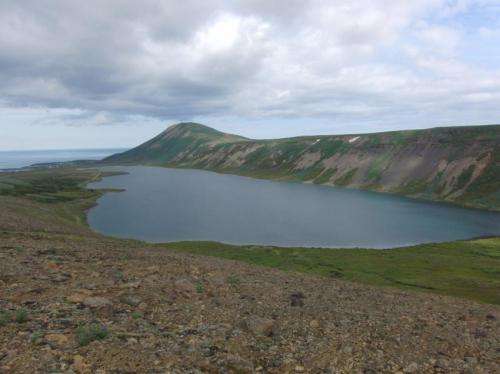September 22, 2014 report
Geologists find well water chemicals changed prior to two different earthquakes

(Phys.org) —A team of researchers with members from Iceland, Sweden and Saudi Arabia has found evidence of chemical changes to underground well water prior to two different earthquakes that occurred in 2012 and 2013 in Iceland. In their paper published in the journal Nature Geoscience, the researchers acknowledge that their findings do not suggest that they have found a reliable earthquake precursor, but they do believe they may be on to something. S.E. Ingebritsen with the U.S. Geological Survey and M. Manga with the University of California, describe the research in a News & Views piece in the same journal issue and suggest that more such research be done.
People have wished there were a way to predict earthquakes for thousands of years—as population centers have grown in size, the urgency has only grown as earthquakes cause massive damage and kill with astonishing regularity. Unfortunately, earthquakes remain the lone natural disaster where no warning can be given for those in a soon-to-be impacted area. That could change, however, if the findings by the team in Iceland prove reproducible.
Scientists have suspected that ground water experiences changes prior to an earthquake—bottled water from a local well was tested before and after the Kobe quake in 1995, and researchers found differences, and similar results were found with well water before and after a quake in China in 1976—but both tests suffered from a lack of data, and because both were single incidents it was difficult to state with confidence if the water change and earthquakes were truly related. In this latest effort, the researchers took a much more systematic approach—they tested groundwater samples every week for the five year period 2008-2013 from an artesian well in the town of Húsavík, a place with a history of earthquakes. They found that levels of hydrogen and sodium in the water increased six months prior to a 5.6 magnitude earthquake in 2012 and again just prior to another 5.5 magnitude earthquake in 2013. Because of the length of the study, the researchers could rule out background variation, and because it happened twice, it offers more confidence that the changes to the water were not just connected to the earthquakes, but were likely caused by changes in the ground that led to the quakes.

As the researchers note, their findings do not mean a way to predict earthquakes has been found, instead it means that the same kind of experiment will have to be conducted in earthquake prone places around the world—if the same results are found, than testing stations can be set up, and perhaps, finally, we'll have a way to alert people to an impending disaster.
More information: Changes in groundwater chemistry before two consecutive earthquakes in Iceland, Nature Geoscience (2014) DOI: 10.1038/ngeo2250
Abstract
Groundwater chemistry has been observed to change before earthquakes and is proposed as a precursor signal. Such changes include variations in radon count rates, concentrations of dissolved elements and stable isotope ratios. Changes in seismic wave velocities6, water levels in boreholes, micro-seismicity8 and shear wave splitting9 are also thought to precede earthquakes. Precursor activity has been attributed to expansion of rock volume. However, most studies of precursory phenomena lack sufficient data to rule out other explanations unrelated to earthquakes. For example, reproducibility of a precursor signal has seldom been shown and few precursors have been evaluated statistically. Here we analyse the stable isotope ratios and dissolved element concentrations of groundwater taken from a borehole in northern Iceland between 2008 and 2013. We find that the chemistry of the groundwater changed four to six months before two greater than magnitude 5 earthquakes that occurred in October 2012 and April 2013. Statistical analyses indicate that the changes in groundwater chemistry were associated with the earthquakes. We suggest that the changes were caused by crustal dilation associated with stress build-up before each earthquake, which caused different groundwater components to mix. Although the changes we detect are specific for the site in Iceland, we infer that similar processes may be active elsewhere, and that groundwater chemistry is a promising target for future studies on the predictability of earthquakes.
Journal information: Nature Geoscience
© 2014 Phys.org
















